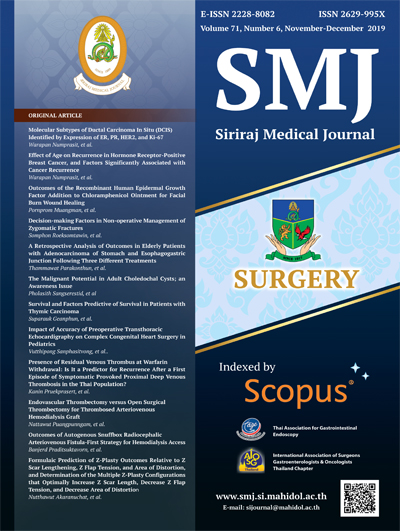Molecular Subtypes of Ductal Carcinoma In Situ (DCIS) Identified by Expression of ER, PR, HER2, and Ki-67
DOI:
https://doi.org/10.33192/Smj.2019.64Keywords:
Clinicopathological features; ductal carcinoma in situ; molecular subtypes; prevalenceAbstract
Objective: The estrogen receptor (ER), progesterone receptor (PR), human epidermal growth factor receptor 2 (HER2), and Ki-67 are used to classify invasive breast cancer into various subtypes. In the case of ductal carcinoma in situ (DCIS), however, the information relating to subtypes using these markers is still limited.
Methods: The pathological specimens of 267 patients diagnosed with DCIS at Siriraj Hospital were analyzed. By using the expressions of ER, PR, HER2, and Ki-67, breast cancer patients were classified into the five molecular subtypes: luminal A, luminal B/HER2 negative, luminal B/HER2 positive, HER2 overexpression, and triple-negative. Based on the specific molecular subtypes, age, clinical presentation, tumor size, and tumor grade were analyzed separately using univariate analysis.
Results: 135 (50.6%), 1 (0.4%), 58 (21.7%), 59 (22.1%), and 14 (5.2%) DCIS were luminal A, luminal B/HER2 negative, luminal B/HER2 positive, HER2 overexpression, and triple-negative, respectively. Patients with luminal A DCIS significantly presented with mass, compared to the other subtypes that displayed with mass and microcalcification in combination (p = 0.008). The luminal A subtype was also associated with tumors of a smaller size (less than 2 cm; p = 0.007) and a lower nuclear grade (p = 0.000) than the HER2 overexpression subtype.
Conclusion: Although luminal A DCIS was the most common DCIS subtype of Thai women, HER2 overexpression DCIS was significantly correlated with poor clinicopathological features, including a large tumor size and a high nuclear grade, which are recognized prognostic factors for tumor recurrence.
Downloads
Published
How to Cite
Issue
Section
License
Authors who publish with this journal agree to the following conditions:
Copyright Transfer
In submitting a manuscript, the authors acknowledge that the work will become the copyrighted property of Siriraj Medical Journal upon publication.
License
Articles are licensed under a Creative Commons Attribution-NonCommercial-NoDerivatives 4.0 International License (CC BY-NC-ND 4.0). This license allows for the sharing of the work for non-commercial purposes with proper attribution to the authors and the journal. However, it does not permit modifications or the creation of derivative works.
Sharing and Access
Authors are encouraged to share their article on their personal or institutional websites and through other non-commercial platforms. Doing so can increase readership and citations.















